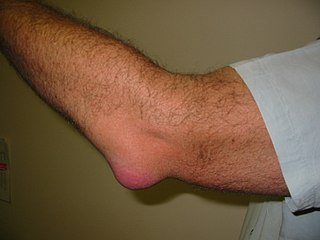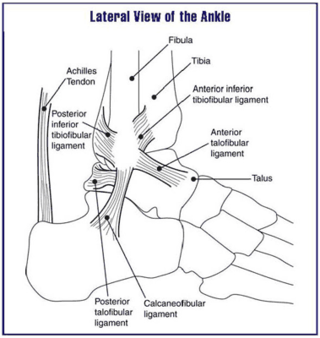Related Research Articles

Arthritis is a term often used to mean any disorder that affects joints. Symptoms generally include joint pain and stiffness. Other symptoms may include redness, warmth, swelling, and decreased range of motion of the affected joints. In some types of arthritis, other organs are also affected. Onset can be gradual or sudden.
Rheumatology is a branch of medicine devoted to the diagnosis and management of disorders whose common feature is inflammation in the bones, muscles, joints, and internal organs. Rheumatology covers more than 100 different complex diseases, collectively known as rheumatic diseases, which includes many forms of arthritis as well as lupus and Sjögren's syndrome. Doctors who have undergone formal training in rheumatology are called rheumatologists.

A joint or articulation is the connection made between bones, ossicles, or other hard structures in the body which link an animal's skeletal system into a functional whole. They are constructed to allow for different degrees and types of movement. Some joints, such as the knee, elbow, and shoulder, are self-lubricating, almost frictionless, and are able to withstand compression and maintain heavy loads while still executing smooth and precise movements. Other joints such as sutures between the bones of the skull permit very little movement in order to protect the brain and the sense organs. The connection between a tooth and the jawbone is also called a joint, and is described as a fibrous joint known as a gomphosis. Joints are classified both structurally and functionally.

Tendinopathy is a type of tendon disorder that results in pain, swelling, and impaired function. The pain is typically worse with movement. It most commonly occurs around the shoulder, elbow, wrist, hip, knee, or ankle.

Shoulder problems including pain, are one of the more common reasons for physician visits for musculoskeletal symptoms. The shoulder is the most movable joint in the body. However, it is an unstable joint because of the range of motion allowed. This instability increases the likelihood of joint injury, often leading to a degenerative process in which tissues break down and no longer function well.

Tietze syndrome is a benign inflammation of one or more of the costal cartilages. It was first described in 1921 by German surgeon Alexander Tietze and was subsequently named after him. The condition is characterized by tenderness and painful swelling of the anterior (front) chest wall at the costochondral, sternocostal, or sternoclavicular junctions. Tietze syndrome affects the true ribs and has a predilection for the 2nd and 3rd ribs, commonly affecting only a single joint.

A sprain is a soft tissue injury of the ligaments within a joint, often caused by a sudden movement abruptly forcing the joint to exceed its functional range of motion. Ligaments are tough, inelastic fibers made of collagen that connect two or more bones to form a joint and are important for joint stability and proprioception, which is the body's sense of limb position and movement. Sprains may be mild, moderate, or severe, with the latter two classes involving some degree of tearing of the ligament. Sprains can occur at any joint but most commonly occur in the ankle, knee, or wrist. An equivalent injury to a muscle or tendon is known as a strain.

Acute septic arthritis, infectious arthritis, suppurative arthritis, pyogenic arthritis, osteomyelitis, or joint infection is the invasion of a joint by an infectious agent resulting in joint inflammation. Generally speaking, symptoms typically include redness, heat and pain in a single joint associated with a decreased ability to move the joint. Onset is usually rapid. Other symptoms may include fever, weakness and headache. Occasionally, more than one joint may be involved, especially in neonates, younger children and immunocompromised individuals. In neonates, infants during the first year of life, and toddlers, the signs and symptoms of septic arthritis can be deceptive and mimic other infectious and non-infectious disorders.

Psoriatic arthritis (PsA) is a long-term inflammatory arthritis that occurs in people affected by the autoimmune disease psoriasis. The classic feature of psoriatic arthritis is swelling of entire fingers and toes with a sausage-like appearance. This often happens in association with changes to the nails such as small depressions in the nail (pitting), thickening of the nails, and detachment of the nail from the nailbed. Skin changes consistent with psoriasis frequently occur before the onset of psoriatic arthritis but psoriatic arthritis can precede the rash in 15% of affected individuals. It is classified as a type of seronegative spondyloarthropathy.

Bursitis is the inflammation of one or more bursae of synovial fluid in the body. They are lined with a synovial membrane that secretes a lubricating synovial fluid. There are more than 150 bursae in the human body. The bursae rest at the points where internal functionaries, such as muscles and tendons, slide across bone. Healthy bursae create a smooth, almost frictionless functional gliding surface making normal movement painless. When bursitis occurs, however, movement relying on the inflamed bursa becomes difficult and painful. Moreover, movement of tendons and muscles over the inflamed bursa aggravates its inflammation, perpetuating the problem. Muscle can also be stiffened.

Synovitis is the medical term for inflammation of the synovial membrane. This membrane lines joints that possess cavities, known as synovial joints. The condition is usually painful, particularly when the joint is moved. The joint usually swells due to synovial fluid collection.

Prepatellar bursitis is an inflammation of the prepatellar bursa at the front of the knee. It is marked by swelling at the knee, which can be tender to the touch and which generally does not restrict the knee's range of motion. It can be extremely painful and disabling as long as the underlying condition persists.

Knee effusion, informally known as water on the knee, occurs when excess synovial fluid accumulates in or around the knee joint. It has many common causes, including arthritis, injury to the ligaments or meniscus, or fluid collecting in the bursa, a condition known as prepatellar bursitis.

Olecranon bursitis is a condition characterized by swelling, redness, and pain at the tip of the elbow. If the underlying cause is due to an infection, fever may be present. The condition is relatively common and is one of the most frequent types of bursitis.

Orthopedic pathology, also known as bone pathology is a subspecialty of surgical pathology which deals with the diagnosis and feature of many bone diseases, specifically studying the cause and effects of disorders of the musculoskeletal system. It uses gross and microscopic findings along with the findings of in vivo radiological studies, and occasionally, specimen radiographs to diagnose diseases of the bones.

Musculoskeletal injury refers to damage of muscular or skeletal systems, which is usually due to a strenuous activity and includes damage to skeletal muscles, bones, tendons, joints, ligaments, and other affected soft tissues. In one study, roughly 25% of approximately 6300 adults received a musculoskeletal injury of some sort within 12 months—of which 83% were activity-related. Musculoskeletal injury spans into a large variety of medical specialties including orthopedic surgery, sports medicine, emergency medicine and rheumatology.

The elbow is the region between the upper arm and the forearm that surrounds the elbow joint. The elbow includes prominent landmarks such as the olecranon, the cubital fossa, and the lateral and the medial epicondyles of the humerus. The elbow joint is a hinge joint between the arm and the forearm; more specifically between the humerus in the upper arm and the radius and ulna in the forearm which allows the forearm and hand to be moved towards and away from the body. The term elbow is specifically used for humans and other primates, and in other vertebrates forelimb plus joint is used.

Knee pain is pain in or around the knee.

Ankle problems occur frequently, having symptoms of pain or discomfort in the ankles.

An antiarthritic is any drug used to relieve or prevent arthritic symptoms, such as joint pain or joint stiffness. Depending on the antiarthritic drug class, it is used for managing pain, reducing inflammation or acting as an immunosuppressant. These drugs are typically given orally, topically or through administration by injection. The choice of antiarthritic medication is often determined by the nature of arthritis, the severity of symptoms as well as other factors, such as the tolerability of side effects.
References
- ↑ "FastStats". US Centers for Disease Control and Prevention. 2023-02-24. Retrieved 2023-04-17.
- 1 2 3 4 5 6 Javed, Mustafa; Mustafa, Saadia; Boyle, Simon; Scott, Fiona (November 2015). "Elbow pain: a guide to assessment and management in primary care". British Journal of General Practice. 65 (640): 610–612. doi:10.3399/bjgp15X687625. ISSN 0960-1643. PMC 4617264 . PMID 26500317.
- ↑ Kim, Helen HR; Gauguet, Jean-Marc (2018-08-01). "Pediatric Elbow Injuries". Seminars in Ultrasound, CT and MRI. ER Imaging: The Traumatized Patient. 39 (4): 384–396. doi:10.1053/j.sult.2018.03.005. ISSN 0887-2171. PMID 30070231. S2CID 51894540.
- ↑ (PDF). 2016-02-03 https://web.archive.org/web/20160203122922/http://www.mountsinai.org/static_files/MSMC/Files/Patient%20Care/Occupational%20Health/RSI_12_with%20monroe.pdf. Archived from the original on 2016-02-03. Retrieved 2023-04-17.
{{cite web}}: Missing or empty|title=(help)CS1 maint: bot: original URL status unknown (link) - 1 2 "Work-Related Musculoskeletal Disorders & Ergonomics | Workplace Health Strategies by Condition | Workplace Health Promotion". US Centers for Disease Control and Prevention. 2021-05-12. Retrieved 2023-04-17.
- 1 2 Kwak, Yee Gyung; Choi, Seong-Ho; Kim, Tark; Park, Seong Yeon; Seo, Soo-Hong; Kim, Min Bom; Choi, Sang-Ho (2017). "Clinical Guidelines for the Antibiotic Treatment for Community-Acquired Skin and Soft Tissue Infection". Infection & Chemotherapy. 49 (4): 301–325. doi:10.3947/ic.2017.49.4.301. ISSN 2093-2340. PMC 5754343 . PMID 29299899.
- 1 2 Ravn, Christen; Neyt, Jeroen; Benito, Natividad; Abreu, Miguel Araújo; Achermann, Yvonne; Bozhkova, Svetlana; Coorevits, Liselotte; Ferrari, Matteo Carlo; Gammelsrud, Karianne Wiger; Gerlach, Ulf-Joachim; Giannitsioti, Efthymia; Gottliebsen, Martin; Jørgensen, Nis Pedersen; Madjarevic, Tomislav; Marais, Leonard (2023-01-12). "Guideline for management of septic arthritis in native joints (SANJO)". Journal of Bone and Joint Infection. 8 (1): 29–37. doi: 10.5194/jbji-8-29-2023 . ISSN 2206-3552. PMC 9901514 . PMID 36756304.
- 1 2 "Osteoarthritis vs. Rheumatoid Arthritis". UCF Health. Retrieved 2023-04-17.
- ↑ Hsu, Joseph R.; Mir, Hassan; Wally, Meghan K.; Seymour, Rachel B.; the Orthopaedic Trauma Association Musculoskeletal Pain Task Force (May 2019). "Clinical Practice Guidelines for Pain Management in Acute Musculoskeletal Injury". Journal of Orthopaedic Trauma. 33 (5): e158–e182. doi:10.1097/BOT.0000000000001430. ISSN 0890-5339. PMC 6485308 . PMID 30681429. S2CID 59252928.
- ↑ Kim, You J.; Wood, Shannon M.; Yoon, Alfred P.; Howard, Julia C.; Yang, Lan Y.; Chung, Kevin C. (January 2021). "Efficacy of Nonoperative Treatments for Lateral Epicondylitis: A Systematic Review and Meta-Analysis". Plastic & Reconstructive Surgery. 147 (1): 112–125. doi:10.1097/PRS.0000000000007440. ISSN 0032-1052. PMID 33002980. S2CID 222169674.
- ↑ Raposo, Filipe; Ramos, Marta; Lúcia Cruz, Ana (December 2021). "Effects of exercise on knee osteoarthritis: A systematic review". Musculoskeletal Care. 19 (4): 399–435. doi:10.1002/msc.1538. ISSN 1478-2189. PMID 33666347. S2CID 232122507.